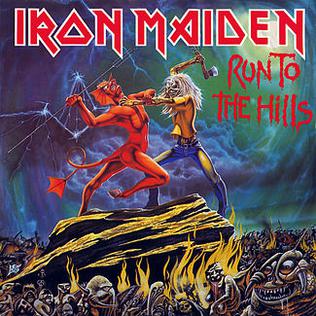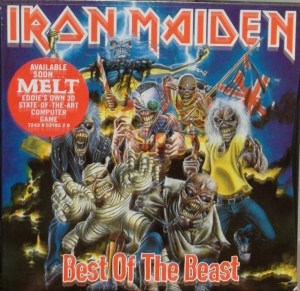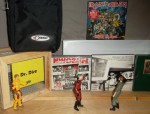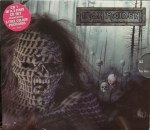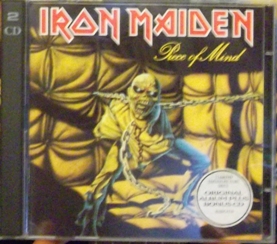GETTING MORE TALE #869: Piece of Mind
Trying to remember exact details is a bit like filling in the blanks, but here are the facts that I know I can state with confidence:
- The vinyl copy of Piece of Mind by Iron Maiden is the original that I bought back for Bob Schipper as a gift in the mid-80s.
- It was purchased at a music store in Kincardine, Ontario.
- It ended up becoming my property because he already had it.
I think it had to be the summer of 1985. I remember being on vacation at the cottage. I was just getting into heavy metal. I know the basics but not the details. Being away from home, I missed my best friend Bob, but I looked forward to getting him a birthday present. I wanted to get him an Iron Maiden album. I thought that he didn’t own Piece of Mind, and there it was in stock at this little music store on the main street of Kincardine. I got it for him, or, more likely, I picked it out and my parents paid for it. I was 12 turning 13.
For some reason, I think the record did not come sealed. Again, memories are hazy here. I might have known two songs: “The Trooper” and “Flight of Icarus”. I seem to remember looking at the credits and wanting to tell Bob about these two guys pictured inside named Martin “Black Night” Birch and Derek “Dr. Death” Riggs. Bob knew the names of the band members, sure, but did he know these two guys? I actually didn’t note that it was spelled “Black Night” instead of “Black Knight”, nor would I have caught the Deep Purple reference if I did.
On the other side of the inner sleeve, I thought Bob would love the photo of the band at the banquet table, Bruce wielding a mean looking blade. At that point, I at least knew who Bruce was. I also recall that the neighbour kids liked Dave Murray least because they thought he looked kind of goofy. Meanwhile, Adrian Smith appears absolutely flabbergasted at the feast before them.
I looked forward to giving Bob the record, but there was a hiccup of some kind. Either he already got Piece of Mind, or the LP format wasn’t good for him anymore. He would have had to play LPs on the living room stereo rather than his own bedroom’s tape deck. It could even have been both those things. Either way, because of that well-intentioned gift, I ended up with my first Iron Maiden.
I consider myself lucky to have this record so early in my life.
By ’86-87, I was spinning it pretty regularly on the turntable. I was lucky enough not only own this album as a young teen, but to even have a turntable in my own bedroom. My parents weren’t going to use it anymore, so they handed it down. Any time they wanted to hear a song from their records, I would tape it for them.
I can recall studying for exams in the 9th grade playing Piece of Mind, and a Triumph single, in constant rotation. Although I should have had my mind on other things, I ended up memorizing the lyrics of the Dave Murray tune “Still Life” instead. It was one of my first love affairs with a deep cut. I mostly memorized “Sun and Steel” too. I practiced singing these songs in my bedroom.
 I had the writing credits committed to memory. I liked all the songs. It was an extraordinary album to me. Few were the albums where I truly liked all the songs. Some more than others, (“Quest For Fire” is perhaps not as good as “Revelations”, yeah?) but I liked them all for their own reasons. Even the twisting, complex “To Tame a Land” was a cool Iron Maiden epic, though certainly not as accessible as “Rime of the Ancient Mariner” or “Alexander the Great”.
I had the writing credits committed to memory. I liked all the songs. It was an extraordinary album to me. Few were the albums where I truly liked all the songs. Some more than others, (“Quest For Fire” is perhaps not as good as “Revelations”, yeah?) but I liked them all for their own reasons. Even the twisting, complex “To Tame a Land” was a cool Iron Maiden epic, though certainly not as accessible as “Rime of the Ancient Mariner” or “Alexander the Great”.
20 years later I went full circle back to Piece of Mind once again dominating a time in my life. I had finally quit the Record Store and was working a blissful job in the mail room at United Rentals. I had just started reading Frank Herbert, starting of course with Dune. This led me right back to Piece of Mind and “To Tame a Land”. And finally, I memorized those lyrics too. “He is the Kwizatz Haderach, he is born of Caladan, and will take the Gom Jabbar”. I finally understand what the shit those words meant! Insofar as a layman in the Herbert world, anyway. The lyrics are a bit ham-fisted, but did it matter? No, of course not, as I sang the words over the incessant rattle of that mail machine.
It was a contraption of aligned (or mis-aligned more often than not) components, at least 10 feet long. Place a carefully sorted stack of invoices in one end, load a handful of windowed envelopes somewhere in the middle, and in theory, the thing would fold, insert, seal and stamp all the mail. In reality it required constant babysitting at almost every step, but I soon became its master. And I sang away in victory:
The time will come for him
To lay claim his crown
And then the foe yes
They’ll be cut down
You’ll see he’ll be the
Best that there’s been
Messiah supreme
True leader of men
And when the time
For judgement’s at hand
Don’t fret he’s strong
And he’ll make a stand
Against evil and fire
That spreads through the land
He has the power
To make it all eeeeeend!
Even over the clanking of that machine, I could still be heard. I knew that, and I kept singing anyway. I actually loved that job and wanted the world to know it. I was so happy to be free of the Record Store.
Playing back Piece of Mind today is like putting on an old familiar T-shirt. It fits just right, no adjustments needed. Eventually you forget that it’s there, except that for persistent smile on your face. Peace of mind indeed.





